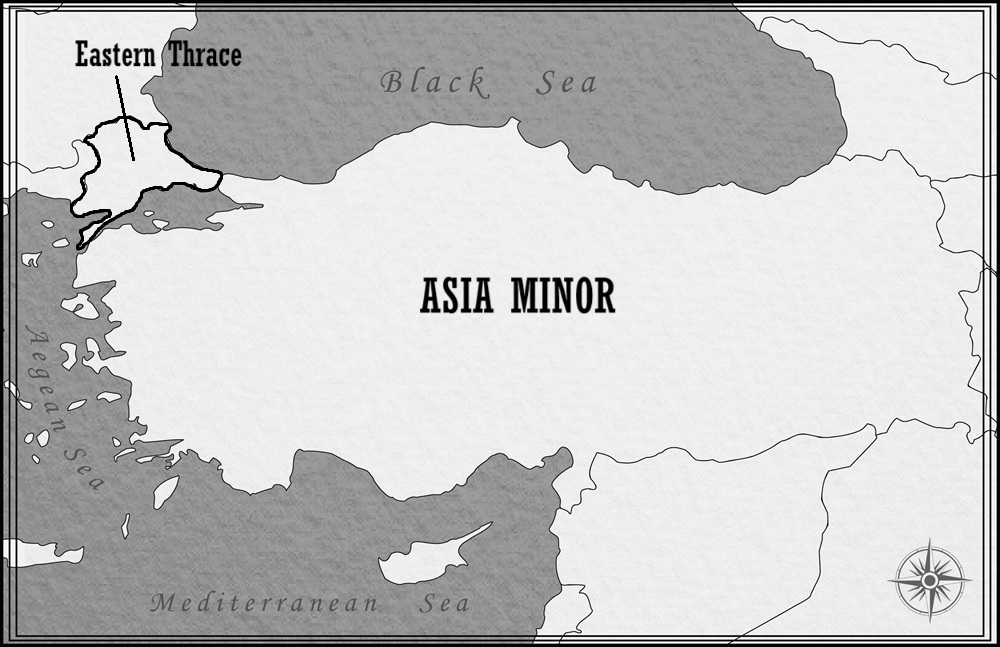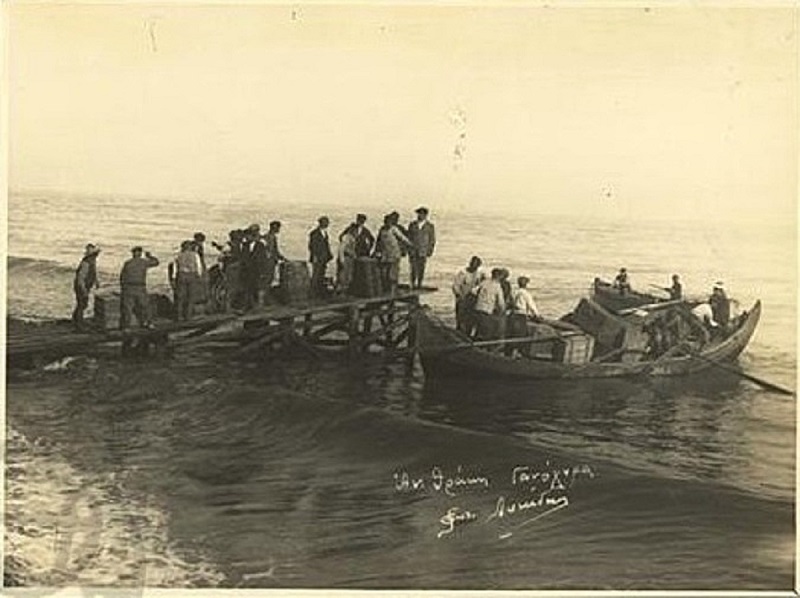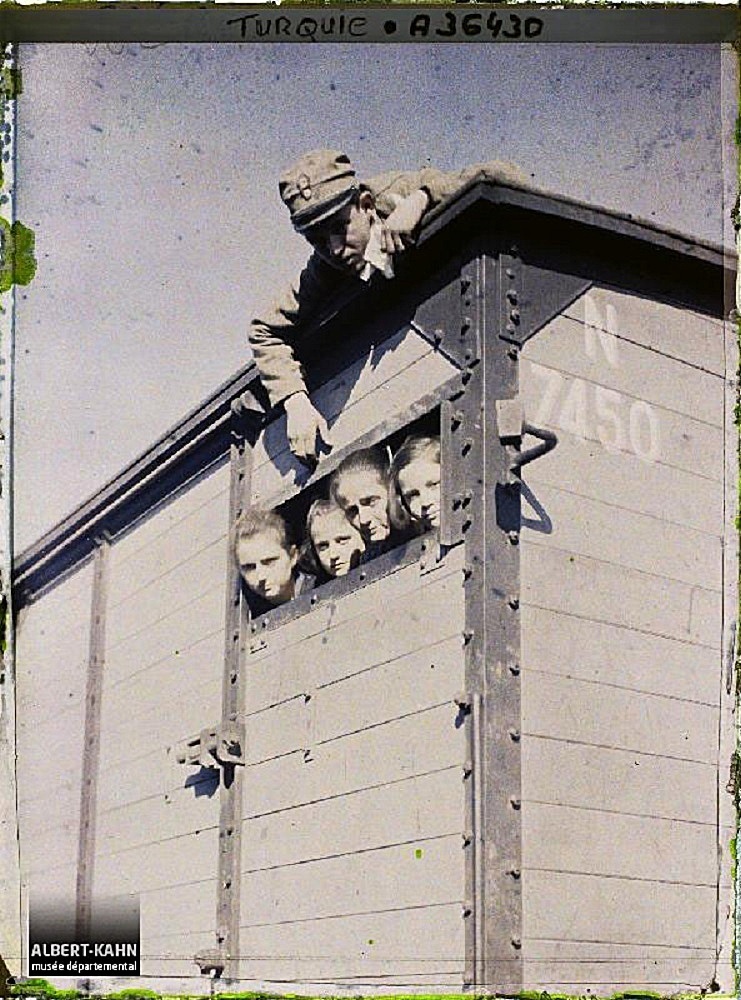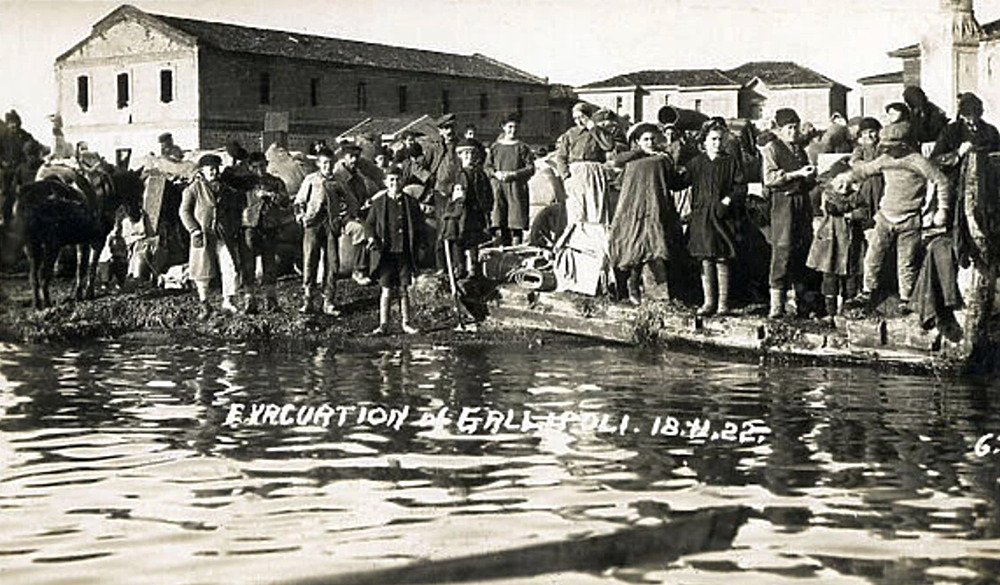To view a detailed map of Eastern Thrace click here
The Greek Genocide began in the region of Eastern Thrace, otherwise known today as European Turkey or Turkish Thrace. At a global conference of Thracian Greeks at Didymóteicho in June 2006, April 6 was assigned as the day of remembrance for the genocide of the Greeks of Eastern Thrace. April 6 was chosen because it was on this day during Easter of 1914 that the persecution of Greeks in the region intensified. The Greeks of Eastern Thrace refer to this day as Black Easter (Gr: Μαύρο Πάσχα).
The regime responsible for the persecution of the Greeks of Eastern Thrace before and during the First World War was the Committee of Union and Progress (C.U.P) otherwise known as the Young Turks. The methods used to eliminate Greeks in the region included, boycotting of businesses, looting, murder, deportation, extortion and the pillaging of towns, villages and places of worship. The methods were so effective, and were met with such little or no resistance and international condemnation, that similar methods were later used against Greeks and other ethnic groups throughout the Ottoman Empire to bring about their destruction.
The population of Greeks in Eastern Thrace at the beginning of the 20th century was more than 350,000. During the genocide, many of these Greeks were exiled to Greece, while 100,000 were deported to the interior of Asia Minor and only half returned.1
Persecutions from 1912-1913
Between the years 1912-1913, 15,690 Greeks were massacred in Eastern Thrace.2 A November report describes how the Ottoman Army at Aivali near Lüleburgaz massacred 167 Greek men, women and children. Four hundred Ottoman cavalry destroyed the Greek villages of Yagato and Golcuk, Bayramiç and Elmalı in the Malgara region. At Keşan, 300 Greeks were massacred.3
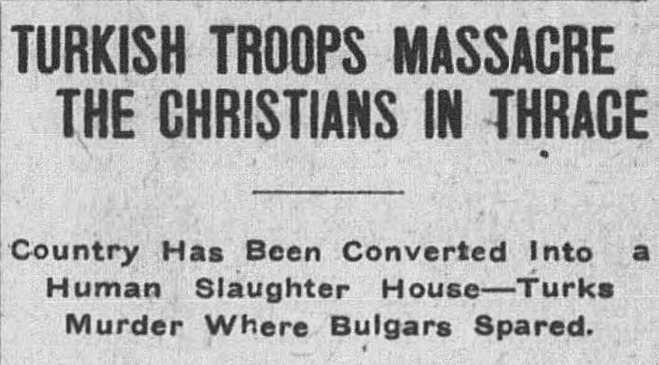
Montpelier Examiner (Idaho), 1 Aug 1913. Source
Massacres of Greeks continued and intensified throughout 1913. In July, the Ottoman Army massacred Greeks at Gönence, Tekirdağ, Hayrabolu, Hasköy, Hemit, Kürtüllü and Bayramtepe and committed widespread looting and rape. The burning of churches and entire villages usually coincided with massacres.4 In the region of Malgara alone, 18 Greek villages were wiped out. The Greek Patriarchate protested vigorously both to the Ottoman Government and foreign consulates but with no effect. In 1913, authorities also implemented a policy of deportation to destroy Greek communities. The deportations escalated in 1914. According to Taner Akçam:
The forcible expulsions and migrations from the area of Eastern Thrace began in the Spring and Summer of 1913. Attacks against the local Christian population continued throughout the year, but after 1914, the forcible removals began to take on a more systematic form.5
Persecutions in 1914
During 1914, the forced deportation of Greek communities in Eastern Thrace began in earnest. Entire villages and towns were uprooted, often with brutal force. On the 6th of April 1914, 200 Greek families from Binkılıç (Gr: Strantza) were deported. After being beaten, stripped of their valuables and having large sums of money extorted from them, Turkish corporals and gendarmes with swords drawn, ordered them to leave. Aspasia Constantinides lived through the deportation and she recounted:
After a two hour march, we reached a deep and narrow ravine where we found Corporal Ismail with a number of immigrants, apparently waiting for us. As soon as he saw us, he ordered our drivers to stop, and dragging the women out of the carts beat them savagely. They snatched the earrings the women wore and in so doing cut their ears; they forced them to undress in order to get at the necklaces they wore, and often tore them off their necks with such violence that in one instance a woman's throat was cut, causing the blood to flow in torrents.6
They arrived at Marmara Ereğlisi (Gr: Heraclea) where they were boarded onto the S.S Markella and deported.
The Teskilat-i Mahsusa (Special Organization, or SO) was a Turkish paramilitary unit that was often used during the genocide to co-ordinate attacks on Greeks. A report dated 8th of April 1914 by one of the foreign embassies in Constantinople made mention of 'Special Committees' operating in the Thrace region that were terrorizing Greeks and forcing them to flee. With the aid of the police, they were confiscating property and making residents sign declarations that they were leaving of their own free will.7 A report by the Consular Agent in Kirklareli on the 23rd of April 1914, stated that the hodjas (Muslim teachers) in local mosques were exciting the hatred of Christians and Greeks, and officials were arming local Turks with army rifles to commit crimes.8
The situation had become so critical for Ottoman Greeks that on the 6th of May 1914, the Greek deputies and senators of the Ottoman Parliament made a protest to the Ottoman Government against the persecution of the Greeks in the Ottoman Empire, but to no avail. Later that month, the Ecumenical Patriarchate declared the Orthodox Greek church in a state of persecution in the Empire and ordered the closure of all churches and schools.
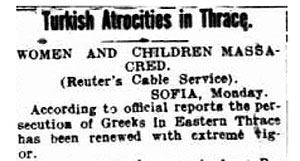
Port Pirie Recorder and Western Mail (South Australia), 19 May 1914, page 2.
In September 1914, the Mudir (local governor) Sarakin Tahsim Bey forced the residents of Yenice (Gr: Skepastos) to hand over 40,000 okas (Ottoman unit of mass) of corn which he then distributed to the Turkish immigrants at Vize. Rigorous boycotts were also enforced on the Greeks of Tekirdağ causing many to flee. Out of 250 shops only 20 remained.9
Yeniköy was located on the main road that linked Gallipoli to Keşan and Constantinople through Tekirdağ. Before 1914, the village comprised 689 people, all Greeks. In 1914, 567 of the village-folk of Yeniköy were deported to Vizir Hani (near Bursa) a distance of 300 km. They were first taken to Şarköy (Gr: Peristasis) and from there deported to the interior of Turkey. Only 275 returned after the war in 1918.10
Persecutions in 1915
Between January and April of 1915, there were reports of Greeks being buried alive and arrests of people on dubious charges. Priests, teachers and entire families were thrown in jail.11 During WW1, Greek males were enlisted into the notorious Labour Battalions (Amele Taburlari) and were literally worked to death, doing back-breaking work with little food or water. The rate of desertion was so high that women were beaten by gendarmes with whips on their soles in order to disclose the location of their husbands. The Greeks in the Diocese of Gallipoli and the Dardanelles were given two hours notice and deported during April 1915 on the pretext of military necessity. They were sent to the interior of Asia Minor without food and water to places near Bandirma and Balikesir some 200 km away. In total, a dozen towns and villages in the Gallipoli region were destroyed and 22,000 Greeks were sent to the interior where they were at the mercy of hostile Turks.12 The Metropolitan of Gallipoli, Konstantinos Koidakis witnessed the persecution of his flock and wrote:
More compassion is shown here to dogs than to the Christian refugees... Close to the Panderma [Bandirma] Railway Station the deaths of the refugees occur daily, and according to my information many die in the interior of the country... The extermination of the Christian refugees is most methodical. If they are deported for strategical reasons alone, they could have been left to settle in the place to which they were originally sent. Such, however is not the case. What is obviously aimed at by constantly shifting them from place to place is to exhaust them and so cause their death.13
Frank W. Jackson, of Pennsylvania, USA was president of the Greek Relief Committee, an organization established during WW1 to provide relief to Greeks during the genocide. In 1917 he stated:
The Greeks of Asia Minor have always been law-abiding and perfectly loyal to the Turkish Government. Under Abdul Hamid they were well treated, but his successors adopted a program to crush them...Along with the Armenians, most of the Greeks of the Marmora regions and Thrace have been deported on the pretext that they gave information to the enemy.14
On the 15th of April 1915, the Greeks of Çavuşköy (Gr: Amygdalia) and Yenice (Gr: Maistros) in the district of Enez were deported to Turkish villages such as Beyendi and Pasait, while the Turks of the nearby villages plundered their properties, churches and monasteries.15 From the 1st to the 15th of May 1915, the Greeks of Büyükdere, Kirits and Yeni-Machala (Dercos district) were deported. In some villages, people were compelled to sign a declaration that they left of their own accord and out of fear. Protests were made regarding these deportations, but even still, the houses and properties of those deported continued to be seized by Turks.16 On the 1st of June 1915, the inhabitants of Burgaz (Gr: Pyrgos) in the district of Dercos consisting of 3,000 persons including men, women and their babies, children and old people were ordered to abandon their villages and forced to walk for hours to Büyükdere. From there they were deported to the interior of Turkey and settled in Turkish villages such as Ik-kiol and Soulio in the district of Iznik. Their homes were seized by Turkish refugees.17
The diocese of Enos (Tr: Enez) was made up of 10,057 Greeks. In August 1915 these Greeks were deported to Malkara. Of the 17 churches, 15 were destroyed and the library which contained 1,900 volumes was pillaged. The monastery of Skalotis was burnt and those of Agios Panteleimon and Tsandiri were completely demolished.18 A report from Constantinople dated 8th of September 1915 stated that all the villages of the district of Kırklareli had been emptied of their Greek inhabitants. From Yenice (Gr: Skepastos) 3,000 Greeks were deported toward Tekirdağ. On the 8th of September 4,000 inhabitants from Sophides were evacuated. The Greeks of Demirköy (Samacovo) in the district of Vize (5,000 inhabitants) were also deported. Tourla and St. Stefano of the Vize district (3,150 inhabitants) were surrounded by Turkish gangs and no one remained.19
In September 1915, the Greeks of Yenice (Gr: Skepastos) were deported after being stripped of all their belongings and they arrived at Heraclea after a four day march. The majority of them crossed over to the Asiatic side and settled at Balikesir and Ada Pazar. Murder and floggings preceded their deportation.20 The town of Üsküp (Gr: Skopos) and its 6,000 inhabitants had a similar fate. On the 5th of September the town was surrounded by gendarmes and 200 Turks under the command of the ex-chief of the Izmit gendarmes, Yussuf Bey. The residents were forbidden from leaving. For five whole days they were subjected to an orgy of cruelty and were stripped of 3.000 Ltq (Turkish lira). Some Greeks were buried alive after being forced to dig their own graves. On the 10th of September they were finally deported.21
Harry Stürmer was a German journalist and correspondent for the Kölnische Zeitung newspaper in Constantinople between 1915-1916. In his memoir titled Two War Years in Constantinople, Stürmer was highly critical of the Turkish authorities and their treatment of Ottoman Greeks. He wrote:
I would like to say here a word about these Greek persecutions in Thrace and Western Anatolia that have become notorious throughout the whole of Europe. They took place just before the outbreak of war, and cost thousands of peaceful Greeks – men, women and children – their lives, and reduced to ashes dozens of flourishing villages and towns.22
Persecutions from 1919-1922
At the conclusion of the First World War, C.U.P leaders responsible for the atrocities against Ottoman minorities during the war were tried in Ottoman courts and many were found guilty of war crimes. While this may have offered some justice to victims' families, the Allied occupation of Constantinople, and the occupation of Smyrna by the Hellenic army in May 1919 led to the formation of the Nationalist Kemalist movement of Mustapha Kemal. The continued persecution of Ottoman Greeks by the Nationalists from 1919-1922 was a continuation of the program initiated by the C.U.P and concluded with their final expulsion.
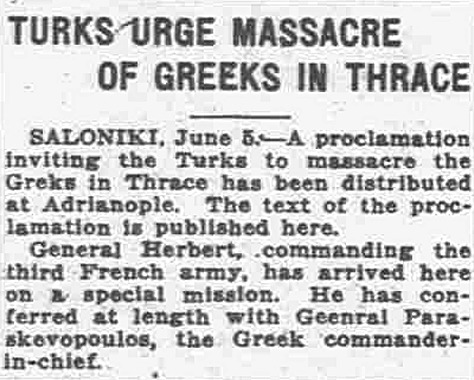
Turks Urge Massacre of Greeks in Thrace. The Washington times. [volume] (Washington [D.C.]), 05 June 1919. Chronicling America: Historic American Newspapers. Lib. of Congress.
Many atrocities committed by the Kemalists from 1919-1922 were reported to the Armenian-Greek Section (A.G.S) which was formed by the British High Commission in Constantinople. Between February 1919 and November 1922, the A.G.S met 87 times and heard numerous reports of atrocities against Greeks, but no action was taken against the perpetrators since the Allies were reluctant to act militarily. On the 20th of May 1919, it was reported that Lieutenant Alwyn Hadkinson, a Relief Officer for Southern Thrace, toured the region and concluded that arms were being distributed with the knowledge and assistance of Government officials. Public security he said was poor and the anti-Christian propaganda was on the increase.23 On the 25th of June 1919, Dr. Theotokas representing the Greek Patriarchate reported that brigandage, murders and pillaging was occurring throughout Thrace.24 The A.G.S heard that the kaimakam (governor) of Shehnikeuy [Şarköy?] was responsible for Greeks of Tekirdağ, Malkara and Keşan abandoning their homes and that the Military Governor of Adrianople was encouraging marauding bands there, and that the situation was worsening.25 At the meeting of 12 November 1919, Mr Calvocoressi representing the Greek Patriarchate reported that Tekirdağ was full of fedais (fighters prepared to sacrifice their lives) who were menacing the Christians. The Turkish notables at Şarköy met at the mosque and stated that they were officially joining the Kemalist Nationalist movement and were preparing to distribute arms and impose payments to those unable to undertake military duty.26 On the 10th of December 1919 the A.G.S heard that Christians returning to their homes at Tekirdağ found that the Turks had taken possession of their houses and were pulling down their churches to build barracks.27 At the A.G.S meeting of the 10th of March 1920, it was reported that five villages at Tekirdağ were pillaged by 50 unknown persons wearing gendarme uniforms. A month earlier Nationalists had arrived at Tekirdağ with their leader and arms were distributed among the population.28
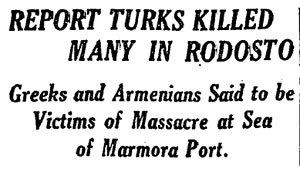
The New York Times, 4 March 1920.
At the 30th of June 1920 meeting, it was reported that the Greeks of Marmara Ereğlisi (Gr: Heraclea) fled to Constantinople after their shops and houses were pillaged and some of the residents were killed. The village of Karahovouz containing 100 families was set on fire and its population massacred.29
The Greeks of Eastern Thrace continued to be persecuted until July 1920 when Hellenic forces were given Allied permission to occupy Eastern Thrace to offer them protection. However this was short-lived. In October 1922, Eastern Thrace was ceded to Turkey after the signing of an Armistice at Mudanya following the Hellenic military defeat in Asia Minor in September 1922. After hearing that Turkish forces were to occupy Eastern Thrace, panic-stricken Christians fled to Greece to avoid meeting the same fate as Christians who were massacred en-masse in Asia Minor the previous month. They fled mostly in ox-carts and on foot.
American writer and journalist Ernest Hemingway (1892-1961) arrived in Constantinople on the 30th of September 1922 as a foreign correspondent for the Toronto Daily Star to report on events following the Smyrna fire. The following month he was in Thrace and witnessed the expulsion of the Greeks. In his October 20 dispatch, Hemingway described the wretched state of Greeks who were attempting the arduous journey to Greece by foot. He wrote:
In a never-ending, staggering march, the Christian population of Eastern Thrace is jamming the roads toward Macedonia. The main column crossing the Maritza River at Adrianople is 20 miles long. Twenty miles of carts drawn by cows, bullocks and muddy-flanked water buffalo, with exhausted, staggering men, women and children, blankets over their heads, walking blindly along in the rain beside their worldly goods.30
The Greeks of Ganochora fleeing their homes, 1922. Photo: Georgios Lykidis. Source: Photographic archive EΛΙΑ-ΜΙΕΤ
A scene during the evacuation of Eastern Thrace. A woman and three children gaze at the camera as they are taken away in a freight train with a soldier above them. Adrianople, November 4, 1922. Photo: Frédéric Gadmer. Source
Evacuation of Gallipoli, 18 Nov 1922.
1. Hofmann, T. The Genocide of the Ottoman Greeks, Caratzas USA, 2011, p 50.
2. Hofmann, T. The Asia Minor Catastrophe and the Ottoman Greek Genocide. Asia Minor and Pontos Hellenic Research Center, 2012, p. 49.
3. Archimandrite Alexander Papadopoulos, Persecutions of the Greeks in Turkey before the European War: On the Basis of Official Documents. New York: Oxford University Press, 1919, pp 24-25.
4. Archimandrite Alexander Papadopoulos, ibid, pp 32-52.
5. Taner Akçam. The Greek Deportations and Massacres of 1913-1914. In: Shirinian, George N (editor), The Asia Minor Catastrophe and the Ottoman Greek Genocide. Asia Minor and Pontos Hellenic Research Center, 2012. p 73.
6. Greek Patriarchate, Persecution of the Greeks in Turkey 1914-1918, Constantinople 1919, 19-20.
7. Arch. Alexander Papadopoulos, ibid, p 91.
8. Arch. Alexander Papadopoulos, ibid, p 98-99.
9. Greek Patriarchate 1919, ibid, 31.
10. Arsenis Paraskakis, The Roots of Thrace, Neohori Peristasis, Viewed 29 March 2016, http://neoxoriperistasis.blogspot.com.au/2014_02_01_archive.html
11. American Hellenic Society, Persecutions of the Greeks in Turkey Since the Beginning of the European War, Oxford University Press, 1918, p 35.
12. File No 391, 867.4016/123, American Embassy Constantinople to the Secretary of State Washington, 10 August 1915.
13. Ecumenical Patriarchate, Persecution of the Greeks in Turkey 1914-1918. Constantinople, 1919. The Hesperia Press, pp. 43-44.
14. Turks Turned Against Greek, 700,000 Suffer, The Evening Independent. 17 October 1917, 6.
15.American Hellenic Society 1918, ibid, 40-41.
16.Ibid, 41.
17.Ibid.
18.Greek Patriarchate 1919, ibid, 16.
19.American Hellenic Society, ibid, 42-43.
20.Greek Patriarchate 1919, ibid, 10.
21.Ibid.
22.Stürmer, H 1917, Two War Years in Constantinople, George H. Doran and Co, New York. 169.
23.Yeghiayan, V (comp.) 2007, British Reports on Ethnic Cleansing in Anatolia: 1919-1922, Center for Armenian Remembrance, USA, 49.
24.Yeghiayan, V, ibid, 68.
25.Yeghiayan, V, ibid, 82.
26.Yeghiayan, V, ibid, 102.
27.Yeghiayan, V, ibid, 112.
28.Yeghiayan, V, ibid, 132.
29.Yeghiayan, V, ibid, 155.
30.Hemingway, E 1922, A Silent, Ghastly Procession, The Toronto Daily Star, 20 October.
Last updated 14 July 2020.

